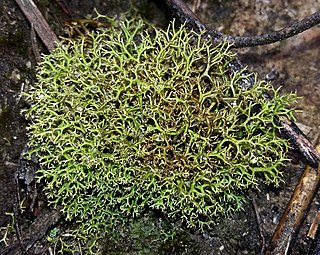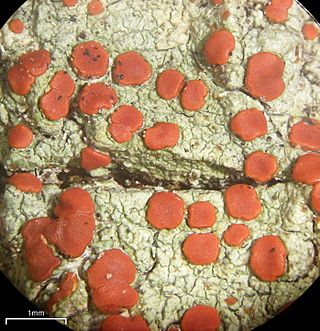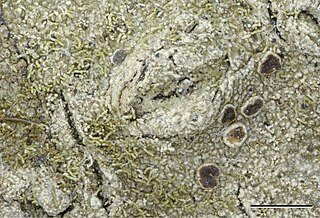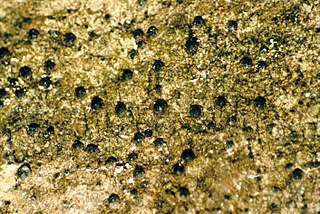
The Baeomycetales are an order of mostly lichen-forming fungi in the subclass Ostropomycetidae, in the class Lecanoromycetes. It contains 8 families, 33 genera and about 170 species. As a result of molecular phylogenetics research published in the late 2010s, several orders were folded into the Baeomycetales, resulting in a substantial increase in the number of taxa.

The Graphidaceae are a family of lichen-forming fungi in the order Graphidales. The family contains nearly a hundred genera and more than 2000 species. Although the family has a cosmopolitan distribution, most Graphidaceae species occur in tropical regions, and typically grow on bark.

Cladia is a genus of lichenized fungi in the family Cladoniaceae. Cladia species have a crustose primary thallus and a fruticose, secondary thallus, often referred to as pseudopodetium. The type species of the genus, Cladia aggregata, is widely distributed, occurring from South America, South Africa, Australasia and South-East Asia to southern Japan and India. Most of the other species are found in the Southern Hemisphere.

Ramboldia is a genus of lichen-forming fungi in the family Ramboldiaceae. The genus was circumscribed in 1994 by Gintaras Kantvilas and John Alan Elix. It was emended in 2008 by the inclusion of Pyrrhospora species containing the anthraquinone russulone in their apothecia and having a prosoplectenchymatous exciple. The family Ramboldiaceae was circumscribed in 2014 to contain the genus.
Hueidea is a single-species fungal genus in the family Fuscideaceae. It contains the species Hueidea australiensis, a saxicolous (rock-dwelling), crustose lichen found on granite rocks in the Mount Kosciuszko area of New South Wales, Australia. Both the species and the genus were described as new to science in 2003 by Australian lichenologists Gintaras Kantvilas and Patrick McCarthy.
Gregorella is a genus of lichenized fungi in the family Arctomiaceae. This is a monotypic genus, containing the single species Gregorella humida.

Chrysothrix is a genus of lichen-forming fungi in the family Chrysothricaceae. They are commonly called gold dust lichens or sulfur dust lichens, because they are bright yellow to greenish-yellow, sometimes flecked with orange, and composed entirely of powdery soredia. Apothecia are never present in North American specimens.

Mycoblastus is a genus of crustose lichens in the family Tephromelataceae. Members of the genus are commonly called blood lichens.

Malmideaceae is a family of crustose and corticolous lichens in the order Lecanorales. It contains eight genera and about 70 species.

Neoprotoparmelia is a genus of crustose lichens that was created in 2018. It contains 24 tropical and subtropical species that mostly grow on bark. Neoprotoparmelia is in the subfamily Protoparmelioideae of the family Parmeliaceae, along with the morphologically similar genera Protoparmelia and Maronina.
Gintaras Kantvilas is an Australian lichenologist, who earned his Ph.D in 1985 from the University of Tasmania with a thesis entitled Studies on Tasmanian rainforest lichens. He has authored over 432 species names, and 167 genera in the field of mycology.

Trapeliaceae is a family of lichens in the order Baeomycetales. The family contains 12 genera and about 125 species.

Varicellaria is a genus of crustose lichens. It is the only genus in the family Varicellariaceae.

Scoliciosporum is a genus of lichens in the family Scoliciosporaceae.
Gyalectaria is a genus of crustose lichens in the family Coccotremataceae. It has three species. The genus was circumscribed in 2010 by Imke Schmitt, Klaus Kalb and Helge Thorsten Lumbsch, with G. jamesii assigned as the type species. The three species transferred to the genus were originally placed in the large genus Pertusaria. Molecular phylogenetics showed that they belong to a lineage distinct from and unrelated to that genus, but with a sister group relationship to the genus Coccotrema. The genus name combines Gyalect- and -aria, taken from the generic name Pertusaria.

Schaereria is a genus of lichen-forming fungi. It is the sole genus in the family Schaereriaceae, which itself is the only family in the Schaereriales, an order in the subclass Ostropomycetidae of the class Lecanoromycetes. Most Schaereria species are crustose lichens that live on rocks. Schaereria was first proposed by Gustav Wilhelm Körber in 1855 and was later taken up by other lichenologists despite periods of disuse.

Megalospora is a genus of lichen-forming fungi in the family Megalosporaceae.
Schizotrema is a genus of lichen-forming fungi in the family Graphidaceae. The genus was circumscribed in 2009 by Armin Mangold and H. Thorsten Lumbsch.
Sagiolechiaceae is a small family of lichen-forming fungi in the order Ostropales. It contains two genera, Rhexophiale, and Sagiolechia, the type genus. The family was circumscribed in 2010 by lichenologists Elisabeth Baloch, Robert Lücking, H. Thorsten Lumbsch, and Mats Wedin. Molecular phylogenetic analysis showed that the two genera formed a distinct clade in Ostropales. Four species were included in the original circumscription of the family.
Gintarasia is a genus of lichen-forming fungi in the family Graphidaceae. It has seven species, all of which are found in Australia. Gintarasia species are corticolous (bark-dwelling), crustose lichens with a thelotremoid form.












